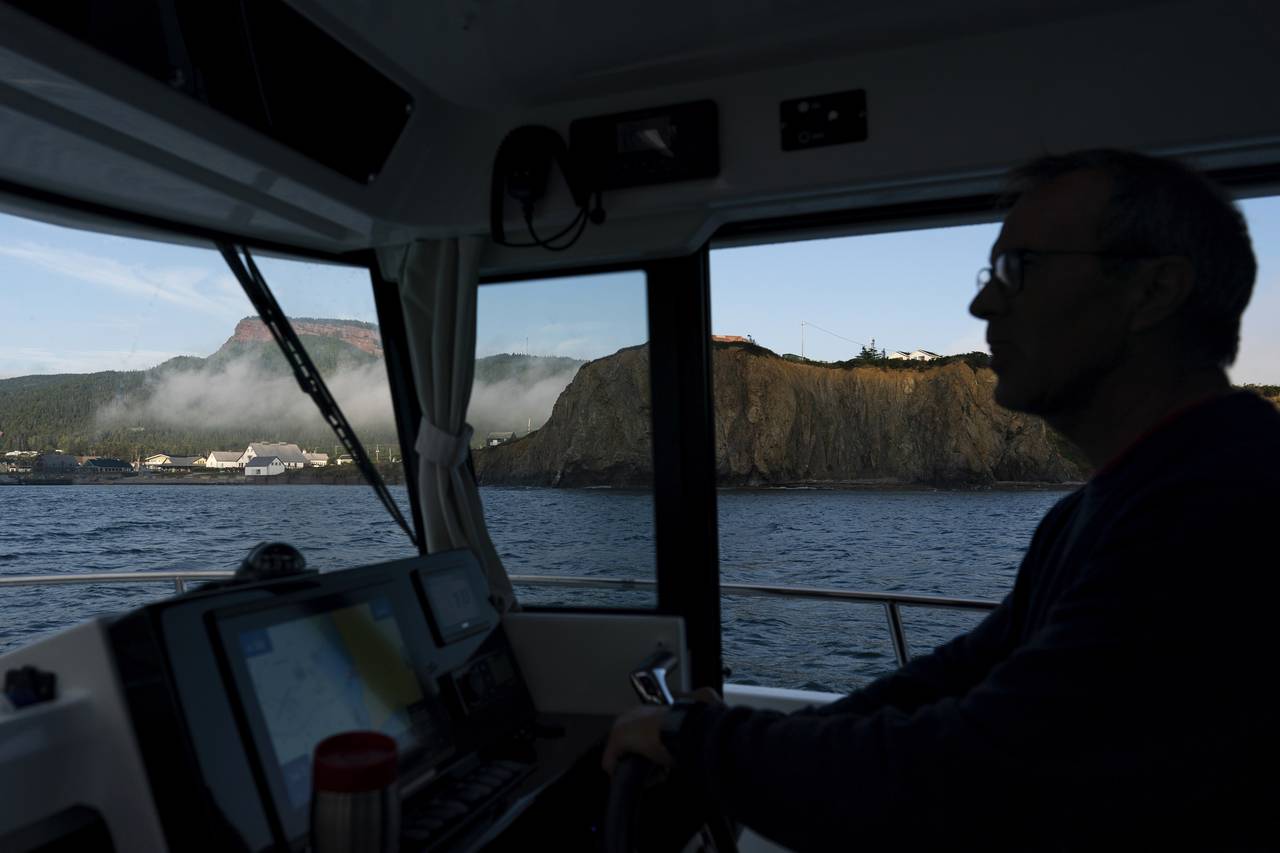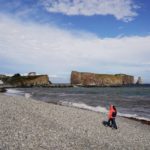A ravaged Quebec coast fights climate change by retreating
Dec 19, 2022, 6:29 PM | Updated: Dec 20, 2022, 8:56 am

Joel Berthelot pilots his boat along the coast of Perce, Quebec, Canada, just after sunrise, Tuesday, Sept. 13, 2022. Against the ravaging seas, Quebec's coastal communities have learned through experience that the way to advance against climate change is to retreat. (AP Photo/Carolyn Kaster)
(AP Photo/Carolyn Kaster)
PERCE, Quebec (AP) — Against the ravaging seas, Quebec’s coastal communities have learned through bitter experience that the way to advance against climate change is to retreat.
Over the past decade, civilization has been pulled back from the water’s edge where possible along the eastern stretch of the Gaspe Peninsula where coastline is particularly vulnerable to erosion. Defenses erected against the sea ages ago have been dismantled, rock by rock, concrete chunk by chunk.
Forillon National Park, nearly 100 kilometers (60 miles) from Perce, removed a road that the ocean turned into heaving chunks of asphalt and scattered with boulders year after year as winters warmed and the shore’s protective sea ice vanished.
In Perce, a town of several thousand that swells with summer visitors drawn to the majestic seascape, a manmade beach was “nourished” with pebbles and given to nature to sculpt. After extreme storms wrecked the town’s old seaside boardwalk, a new one was built farther from the water and without the concrete wall that had only added to storm wave fury.
When you try to wall off the sea, communities here learned, the sea prevails. Less destruction happens when waves have less to destroy.
The idea is to “move with the sea, not against it,” said Marie-Dominique Nadeau-Girard, services manager at the Quebec park that encompasses the world renowned seabird sanctuary of Bonaventure Island and the enormous Perce Rock, a natural marvel and cultural touchstone that dominates the panorama.
“We have to work with the elements,” she said from offices of Parc national de l’lle-Bonaventure-et-du-Rocher-Perce. To fight nature is to realize “we’re not going to win.”
So, too, at Forillon, where park ecologist Daniel Sigouin says: “We decided to retreat, and let nature evolve naturally.”
Not every place in the world where climate change accelerates coastal erosion can roll with the punches like this. Expensive condos crowding U.S. beachfronts aren’t going anywhere unless or until the warming climate and rising oceans make such seaside living unsustainable.
But the Gaspe Peninsula’s approach is a test case for far-flung places where strategic capitulation to nature is possible, even with historic human settlements in the mix.
THE VANISHING ICE
Along the peninsula’s shores, once-dependable buffers of coastal ice in deep winter have been largely absent for a quarter century and may well vanish from living memory.
In Perce, the ritual of trekking across ice floes to Bonaventure, 3 kilometers (almost 2 miles) from the town hasn’t been possible for several decades. It is probable, said meteorologist George Karaganis of the Canadian Ice Service, that “20 or 30 years on, those people who walked to Bonaventure Island will all be gone — people will never remember walking to Bonaventure.”
Sigouin, a Forillon biologist, is author of a recent report on a seven-year project to adapt the park to climate change. “In winter, there was always ice cover from December to late March,” he said. “That ice cover was protecting the coast from coastal erosion.
“But as temperatures are getting higher and higher, in that area, there’s almost no ice anymore. As ice is less and less present, we have seen more and more the effect of coastal erosion.”
High cliffs are not exempt from what’s happening at sea level.
“One of the things with climate change, you have more and more periods of freezing and unfreezing rocks, temperatures varying over and under zero degrees Celsius,” Sigouin said. “The water that goes into the rocks will tend to break the rock when it freezes. You have more cliff erosion because of it.”
THE END OF NORMAL
The story of modern Canadian winters, indeed all seasons, is one of disruption attributed to warming temperatures and rising seas. A 2019 government report on a decade of acceleration in the retreat and thinning of Arctic and alpine glaciers called it “unprecedented over several millennia.”
Less snow falls in much of Canada on average, the duration of Arctic lake ice cover is down 80%, storm surges and waves appear more intense and the permafrost is no longer permanent in places, the study found.
“Historical warming has led to changes in rain and snow, rivers and lakes, ice, and coastal zones,” it concludes.
Karaganis, who tracks and forecasts Gulf of St. Lawrence ice cover for the government, seafarers and scientists, produced charts showing the long-term decline of accumulated ice in those waters. From 1971 through 1995, he said, the amount of ice was above the modern median almost every year, but “after 1996, almost every year is below that median line.”
AT LAND’S END
The Canadian government’s project at Forillon was designed to yield to the coast’s natural rhythms, restore a particular spawning ground for capelin and let the waves win. Yet officials also were mindful of preserving — and honoring — the human imprint.
The peninsula is lightly populated and has much less wealth than the maritime playgrounds of the U.S. Atlantic coast. But it’s central in the founding of New France — French explorer Jacques Cartier made landfall in the early 1500s and colonists settled coastal hamlets in the late 1700s.
The park is where the Irish Monument stands — recently relocated farther inIand — in memory of the 120 to 150 lives lost when the Carricks, an Irish ship bound for the St. Lawrence River, ran aground off the coast of Cap-des-Rosiers on April 28, 1847.
Only in 1968 was the ship’s bell found, on a beach more than 600 kilometers (nearly 400 miles) to the northeast near Labrador. And in 2011, a huge storm uncovered human bones from a mass grave of 21 of the shipwreck’s victims, mostly women and children. The remains were buried at the monument’s new site.
For all of that history, the Forillon climate project still was able to eliminate infrastructure along 80% of the coastline. In addition to removing a road, relocating the monument and rehabilitating natural habitats, the park took away stacks of large rocks known as riprap — a common defense for seaside roads and facilities that has come to be seen as part of the problem.
At a spot in Forillon where the International Appalachian Trail from Maine ends, a lighthouse and abandoned outbuilding stand on a rugged cliff overlooking the sea far below. Human residents have long been absent; the local population is porcupines and bears.
BY THE ROCK
Immortalized by explorers back to the 1500s and artists and poets ever since, the Perce Rock stands as testament to the natural processes of erosion even without climate change.
The massive formation sheds hundreds of tons each year. Where once there were at least three arches, now there is only one, and a distant day will come when “the pierced rock” itself will disappear.
The picturesque town that looks out on that icon, though, is grappling with more immediate consequences of global warming.
In Perce, violent weather in 2016, capped by a devastating December storm, convinced officials the old ways of holding back the sea would not do.
By then it had become apparent rigid structures such as the town’s damaged seawall often made the risks of destruction worse.
Rather than absorbing wave energy, seawalls and riprap can create backwash that collides with incoming waves, engineers realized, setting off supercharged turbulence that chews away at shoreline protection and hastens erosion of adjacent land.
“When you have a rigid structure protecting against erosion, if waves hit a wall at 90 degrees, part of the force goes up, splashing water, it’s spectacular,” said Sigouin. But “part of the force goes down, and it washes away the underwater portion of the beach.”
In Perce’s areas where rigid protections had been built over generations, the width of beaches decreased by about 70%.
In 2017, with such obstacles gone, 7,500 truckloads of coarse pebbles, like ones found naturally on the region’s beaches, were deposited at the town’s South Cove and left for the sea to arrange in a gentle slope to absorb the power of the waves gradually.
One of two towers built after the storms to provide views of the damage was kept in place “as a reminder of Perce’s fragility and vulnerability to climate change,” a display says, “and to offer to more people a breathtaking view of the coastline and the Gulf.”
The display adds: “We now know that seafronts should remain as natural as possible to preserve and even improve the ability of coastal systems to adapt to climate change.”
Officials project that the cove’s rehabilitation will last 40 to 50 years. But who really knows?
“Beyond the next few decades, the largest uncertainty about the magnitude of future climate change is rooted in uncertainty about human behaviour,” says the 2019 Canadian study — namely “whether the world will follow a pathway of low, medium or high emissions.
“Until climate is stabilized,” it says, “there will not be a new ‘normal’ climate.”
___
Larson reported from Washington.
___
Associated Press climate and environmental coverage receives support from several private foundations. See more about AP’s climate initiative here. The AP is solely responsible for all content.
Copyright © The Associated Press. All rights reserved. This material may not be published, broadcast, rewritten or redistributed.





























